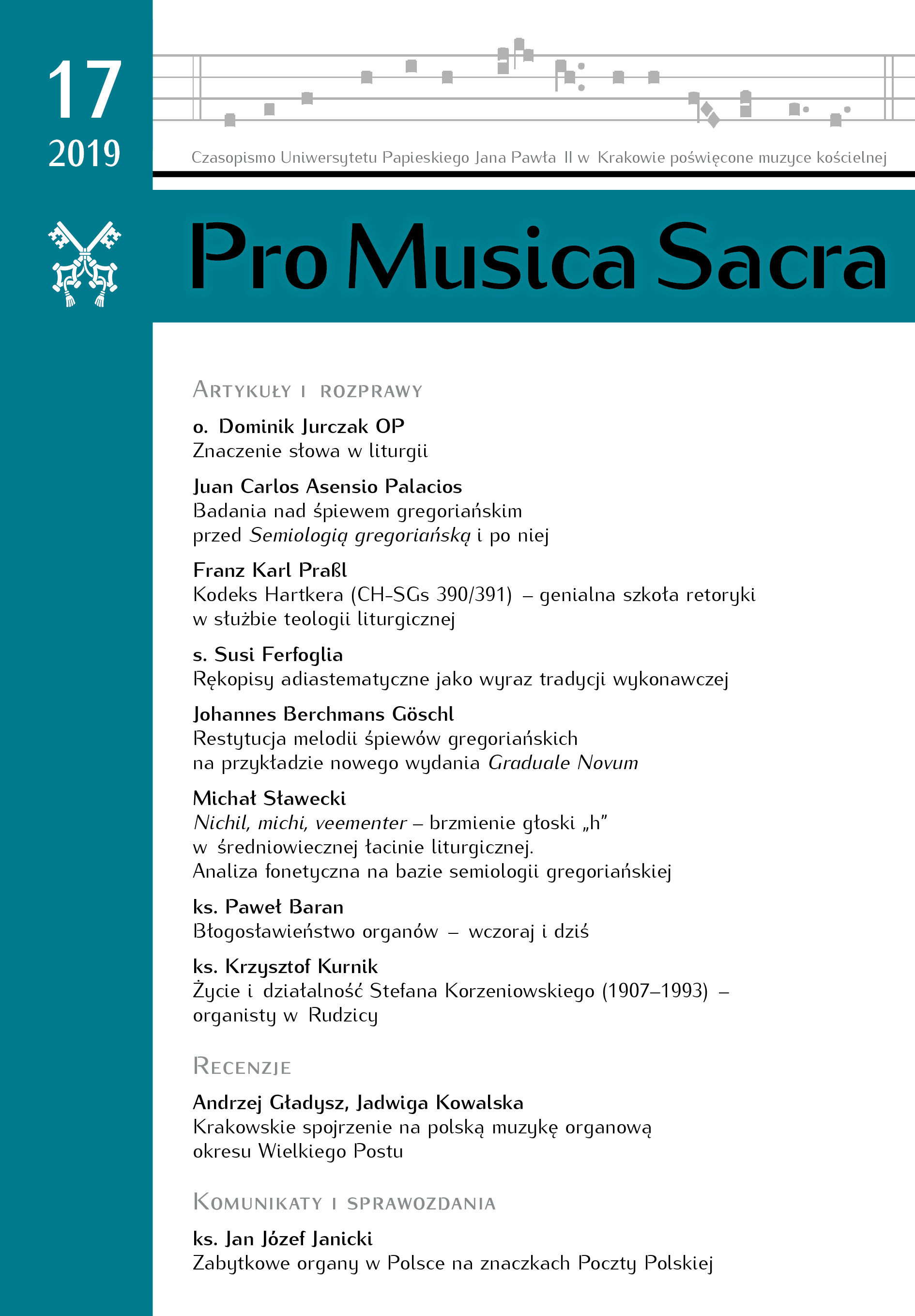Restytucja melodii śpiewów gregoriańskich… na przykładzie nowego wydania Graduale Novum
DOI:
https://doi.org/10.15633/pms.3493Słowa kluczowe:
orientacja semiologiczna, rękopisy adiastematyczne, rękopisy diastematyczne, akcent frazeologiczny, protus, artykulacja werbalna, edycja watykańska, cantatorium, litterae significativae, studia komparatystyczne źródeł, studia komparatystyczne formułAbstrakt
Bez wątpienia Graduale Romanum z 1908 roku (GR 1908) był pionierską pracą na najwyższym poziomie. Jeśli chodzi o jakość melodii, wydanie to zdecydowanie przekracza poziom wszystkich poprzednich edycji. Z drugiej strony GR 1908 daleki jest od idealnej książki. Zwłaszcza jeśli przyjrzymy się mu z perspektywy semiologii, będziemy musieli zmierzyć się z wieloma rozbieżnościami między wersją melodyczną GR 1908 (a w konsekwencji Graduale Triplex) a danymi paleograficznymi i ich semiologicznymi ustaleniami.
Ponadto konieczność restytucji melodycznej wersji GR 1908 nie mierzy się liczbą dźwięków wymagających korekty, jak można to zaobserwować na przykładzie kilku fragmentów introitu Resurrexi w Niedzielę Wielkanocną. Dość często wystarczy zmiana pojedynczego dźwięku, aby całkowicie zmienić strukturę modalną i ekspresję utworu.
W związku z tym konieczne było przywrócenie melodii GR 1908, które zostało zrealizowane przez międzynarodowy zespół badawczy „Melodierestitution”. Wyniki ich prac zostały opublikowane w dwóch tomach Graduale Novum (Regensburg–Città del Vaticano 2011 i 2018).
Jeśli chodzi o metodologię restytucji melodycznej, podstawowa zasada była następująca: punktem wyjścia i najwyższym autorytetem dla wszelkich prac nad restytucją melodii gregoriańskich są najstarsze rękopisy adiastematyczne z X wieku, zwłaszcza cantatorium
St. Gall. 359, Laon 239 i Einsiedeln 121. Najważniejszym zadaniem było poszukiwanie
jak najbliższej melodycznej korespondencji z danymi z rękopisów adiastematycznych.
W tym celu należało skonsultować i zbadać także najważniejsze źródła diastematyczne,
przede wszystkim Benevento 34 i Paris B.N. lat. 776 (Albi). Łączna liczba wszystkich rękopisów
konsultowanych przez grupę roboczą wynosi około sto pięćdziesiąt.
Bibliografia
Antiphonale Missarum Sancti Gregorii (IX–Xe siècle), Codex 239 de la Bibliothèque de Laon, ed. G. Beyssac, Tournai 1909 (PM I/10).
Cantatorium (IX siècle), no 359 de la Bibliothèque St. Gall, red. A. Mocquereau, Tournai 1924 (PM II/2).
Le Codex 10673 de la Bibliothèque Vaticane, fonds latin (XIe siècle), Graduel Bénéventain, ed. R. J. Hesbert, Tournai 1931 (PM I/14)
Le Codex 121 de la Bibliothèque d’Einsiedeln (X–XIe siècle), Antiphonale Missarum Sancti Gregorii, ed. A. Mocquereau, Solesmes 1894 (PM I/4).
Codices gregoriani III, ed. N. Albarosa H. Rumphorst i A. Turco, Padwa 2001.
Göschl J. B., Graduale Novum, editio magis critica iuxta SC 117, Kommentar, Ratisbona 2018.
Graduale de tempore iuxta ritum sacrosanctae romanae Ecclesiae, Editio Princeps (1614), ed. G. Baroffioi M. Sodi, Città del Vaticano 2001.
Graduale Novum, t. 1, Regensburg–Roma 2011.
Graduale sacrosanctae romanae Ecclesiae de tempore et de sanctis, Roma 1908.
Graduale Triplex, Solesmes 1979.
Monumenta Paleografica Gregoriana t. 1, Münsterschwarzach 1986.
Monumenta Paleografica Gregoriana, t. 2, Münsterschwarzach 1986.
Paléographie musicale, Deuxième série (Monumentale) II, Berna 1968.
Paléographie musicale XVIII, Bern 1969.
Paléographie musicale X, Bern 1971.
Paléographie musicale XI, Bern–Frankfurt 1972.
Paléographie musicale XIX, Bern 1974.
Praßl F. K., Codex St. Gallen 342 – das älteste vollständige Graduale aus St. Gallen, t. 1, w: Beiträge
zur Gregorinik 50, s. 49–78; t. II w: BzG 55, s. 75–100.
Rumphorst H., Handschriftenliste 2014, w: BzG 57, s. 41–50.
Pobrania
Opublikowane
Numer
Dział
Licencja
Autorzy publikujący w czasopiśmie udzielają jego wydawcy zgody o następującej treści:
- Autor zachowuje autorskie prawa majątkowe do utworu, a jednocześnie udziela wydawcy czasopisma zgody na jego pierwszą publikację w wersji drukowanej i wersji online na licencji Creative Commons Uznanie autorstwa 4.0 Międzynarodowe oraz zgody na wykonywanie opracowań, w tym przekładów.
- Autor ma możliwość udzielania zgody niewyłącznej na opublikowanie utworu w wersji, która ukazała się w czasopiśmie (np. zamieszczenia go w repozytorium instytucjonalnym lub opublikowania w książce), wraz z informacją o jego pierwszej publikacji w czasopiśmie.
- Autor może umieścić swój utwór online (np. w repozytorium instytucjonalnym lub na swojej stronie internetowej) jeszcze przed zgłoszeniem utworu do czasopisma.

